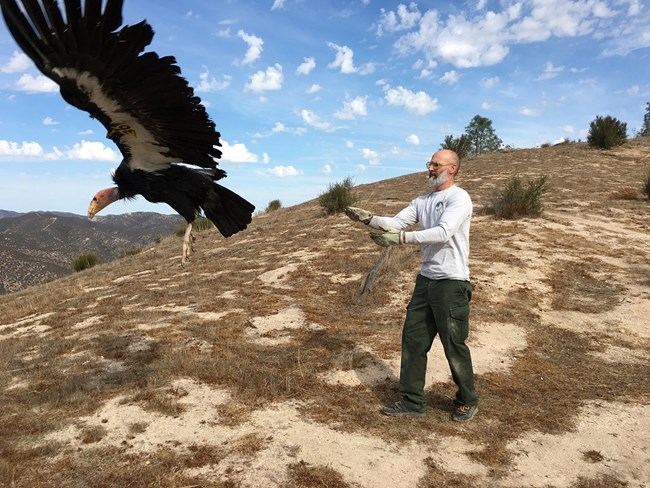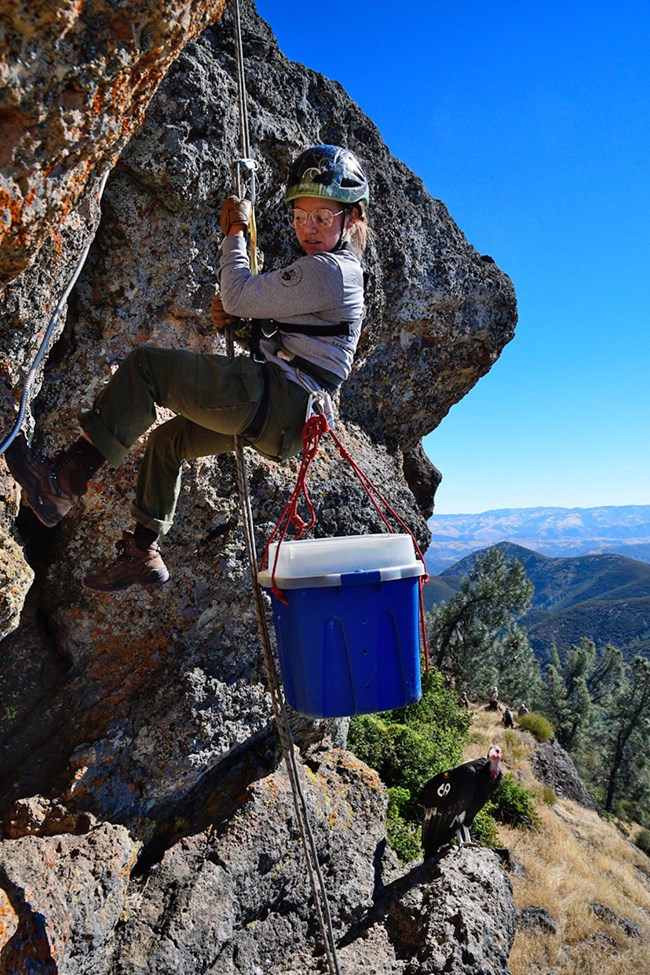
NPS/Arianna Punzalan
Brought back from the brink of extinction in the mid 1980s, California condors have steadily increased their numbers, thanks to the tireless efforts of biologists, researchers, local landowners, ranchers, hunters, and many partner organizations. Management of recovering California condor populations has evolved over time, and currently reflects an intensive, complex, and inspiring blend of efforts by many individuals and organizations.
California condors once ranged from British Columbia, Canada down to Baja California, Mexico. This range shrank with the increase of European settlers moving west. The causes of the decrease in condors included poisoning, shooting, habitat degradation, and the collection of eggs and feathers. By the late 1800s, naturalists were already making note of the California condors’ declining numbers and in 1967, at a population size of 60, they became the first ever officially listed endangered species. Despite this protection, their population continued to decrease and dropped to a low of 22 individuals in 1982. All wild condors were then trapped and placed in captive breeding programs in an effort to save the species from extinction. Wild releases were initiated in 1992 in Southern California but did not suceed so all birds were returned to captivity in 1994 for program re-evaluation. Wild released began in 1995.
Captive-bred condors are released into the wild yearly at six different sites into five different flocks that do not overlap: Hopper Mountain Wildlife Refuge Complex (Southern California, USA [S-CA] flock est.1995), Vermillion Cliffs National Monument (Southwest [SW] or Arizona/ Utah, USA flock est. 1996), Pinnacles National Park and Big Sur (Central California [C-CA], USA flock est.1997 and 2003 respectively), Baja California, Mexico (Mexico [MX] flock est. 2002), and Redwood National Park (Northwest [NW] California, USA flock est. 2022. Different partners monitor each flock’s behaviors, movements, nesting attempts, and mortalities throughout the year. See the below table for flock sizes over the years.

NPS/Gavin Emmons
Each wild condor is outfitted with a visual ID tag and at least one radio transmitter. Some birds are also given GPS transmitters. These allow biologists to track the movements and behaviors of the flock using radio telemetry and GPS mapping. If you are interested in identifying or learning more about a tagged bird in the wild please visit CondorSpotter.
A crucial part of any endangered species recovery program is documenting and addressing threats. Through tracking efforts, biologists are able to recover deceased condors from the field and submit them for necropsy and analysis in an attempt to determine the cause of death. Gaining an understanding of threats to the species assists the recovery program in addressing these hazards.
Beginning in the late fall, condor biologists are busy identifying potential breeding pairs for next spring. Pairs are monitored for breeding displays and are closely observed to determine breeding territories. Once a nest is identified, biologists monitor it regularly and determine if the nest is safe to enter. If so, biologists will conduct health checks on the chick, remove trash from the nest, and outfit the nestling with a radio transmitter and vinyl ID tag when it is 4 months old. Chicks will remain in the nest for approximately 6 months and will stay in their nesting area for several months after fledging, or flying from the nest. Biologists continue to monitor the nesting area until the fledgling is fully integrated into the flock.
Additionally, biologists attempt to trap every wild condor yearly in order to repace transmitters and test blood for elevated lead levels, since lead poisoning is still the main cause of death for condors.
Since reintroduction, California condor numbers in the wild have slowly increased thanks to wild nesting and the release of captive-bred condors (see table below). As of the end of 2019, there were a total of 518 condors in the world, with 337 of those flying free in the wild. However, condors today are still dying due to threats like lead poisoning, consuming litter and microtrash, and electrocution from power poles. Learn more about what you can do to help condors and other wildlife here.
California Condor Recovery by the Numbers
KEY:
S-CA= Southern California Flock established 1995;
SW= Southwestern (Arizona / Utah) Flock established 1996;
C-CA= Central California Flock established 1997;
MX= Baja California, Mexico Flock established 2002;
NW= Northwestern California Flock established 2022.
| Dec31 of YEAR | Captive Flock | S-CA Flock | SW Flock | C-CA Flock | MX Flock | NW Flock | Total Wild | Total Pop. |
|---|
Last updated: April 5, 2023
